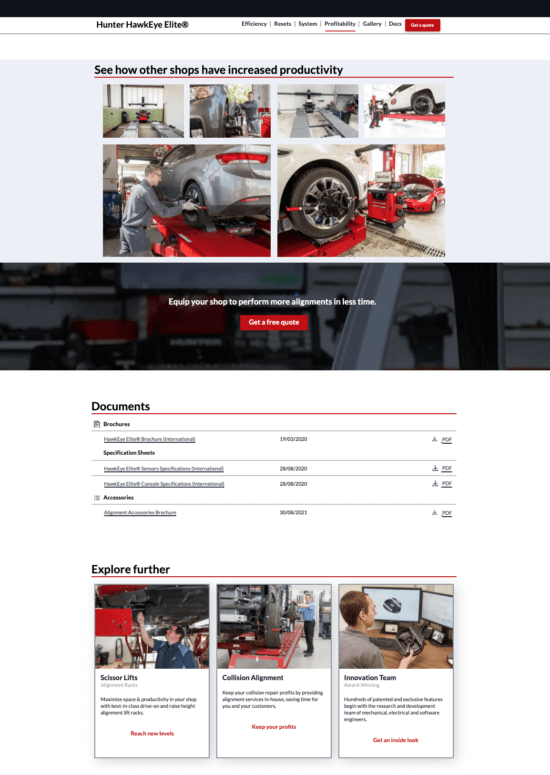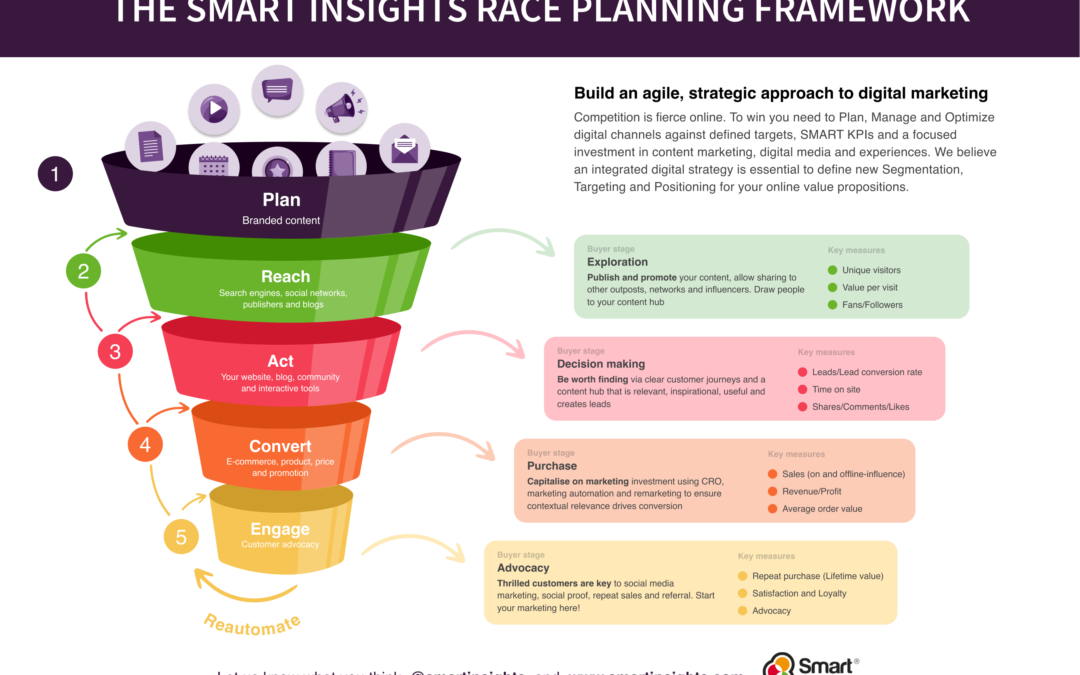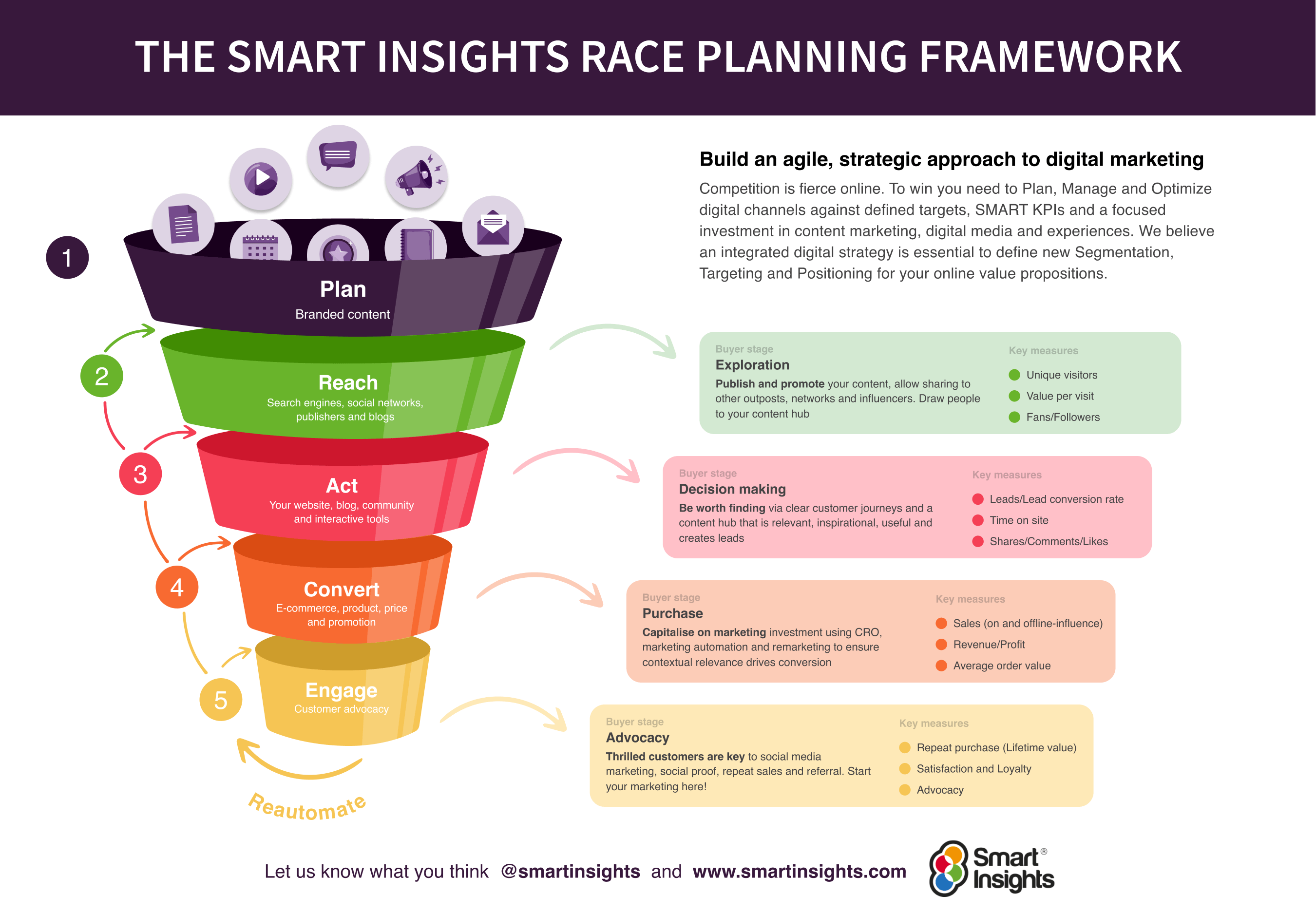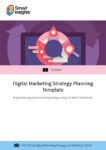Find out how to use the RACE Framework to optimize a more people-centric approach to marketing for manufacturing
In manufacturing, marketing enables you to connect with both wholesalers and distributors, ensuring that your product reaches your customers.
However, as our target decision-makers are becoming familiar with online models for other products and services, so too must we as manufacturing marketers consider if we are still using the most appropriate tools for the job.
Digital marketing has evolved tenfold in the last few years. And, whilst the adoption of new omnichannel marketing strategies has varied across different sectors, in manufacturing today we are seeing some great examples of a people-centric approach to marketing.
When considering your options for how to market a manufacturing company, the RACE Framework is a really useful system for visualizing customer journeys. As such, the below examples will be structured across RACE.
(Plan) > Reach > Act > Convert > Engage
The RACE Framework focuses on how to improve your marketing across the full customer lifecycle, or marketing funnel: from creating awareness, building an audience, encouraging interaction and lead generation, to purchase, and then loyalty.
If you’re looking for new marketing solutions for your manufacturing company, you’ve come to the right place. The RACE Framework is our simple, streamlined marketing strategy for businesses to plan, manage, and optimize their marketing activities and drive results.
Our free digital marketing plan template helps marketers assess their current plan against our systematic method for optimizing each stage of our customers’ journeys. Download your free copy today.
Plan how to market your manufacturing company
The RACE Framework is used in manufacturing marketing as a planning system to cover the paid, owned, and earned inbound marketing activities to encourage purchase. Within the planning stage, you should:
- Create an integrated manufacturing marketing digital strategy for future growth
- Define the resources needed to implement the strategy
- Improve customer focus by segmenting your audience through digital media
- Develop your online content to grow leads and sales and create a more engaging brand
The Manufacturing Buying Cycle
When looking at how to market a manufacturing company, the Manufacturing Buying Cycle should be taken into consideration. It involves six key steps (though there may be many more):
1. The purchaser identifies the NEED for a product or service
2. The purchaser RESEARCHES information to solve a problem
3. If the DESIGN is new, the purchaser researches product data
4. The purchaser seeks and EVALUATES suppliers for their chosen solution
5. The purchaser creates a SHORTLIST of those it wants to consider
6. The buyer PURCHASES from their chosen supplier

When prospective customers are researching suppliers, they will most likely evaluate their:
- Brand and reputation
- Presence in the market
- Testimonials and case studies from your customers
- Ratings and reviews
- Social media channels
- Website
Reach a wider manufacturing audience
Reach involves building brand awareness on other websites and offline media to build traffic to your main site by using, for example, microsites and social media. When looking at how to market a manufacturing company, it’s important to make sure you are generating quality visits to your main site by utilizing:
Social Media:
It is essential to develop a social media strategy that prevents wasted efforts that don’t generate the kind of impact that was hoped for. It should be driven by an in-depth understanding of customer preference and focus on:
- Innovation: using social media networks such as LinkedIn, manufacturers connect with industry forward-thinkers and boost workplace innovation.
- Alignment: whether you’re engaging with customers or keeping track of your competitors, the information and insight you gain from social interactions can help ensure your efforts remain aligned with buyer needs.
- Reach: social media is perhaps one of the easiest ways to expand your reach.
- Awareness: manufacturers are always looking to boost awareness of their products and brand. Decision-makers spend longer on social media than average web users, so these channels are very important.
- Loyalty: by building a strategy rooted in the unique needs and goals of your manufacturing business you can generate a wealth of new opportunities and gain customer loyalty for future growth and development.
Google Ads:
Tactical marketing, including advertising tools such as Google, is important when looking at how to market a manufacturing company. It is measurable, realistic and should be a key part of your online advertising strategy.
Pay-per-click advertisements, including Google search ads, are the third-largest generator of customer conversions online. According to Google, brand awareness can be increased by 80% by the appearance of search ads alone.
Award Submissions:
A manufacturing industry or regional award win or shortlist will increase your sales, because customers are far more likely to invest in products that have been highly rated. They are an inexpensive way to increase the visibility and credibility of your manufacturing business.
Public Relations:
Public relations (PR) is how you, as a manufacturing business, communicate with your wider audience and how you disseminate information. The focus is on communication, your reputation, and exposing your brand. Opportunities for PR can also be found in trade journals by offering trend stories, positioning your company as industry thought leaders.
Create a plan to fill your marketing funnel and reach more high-value manufacturing customers with our free digital marketing plan template.
Influence customer interaction on your site
This includes enhancing your content strategy and the digital experience of your website in
supporting the customer journey. Someone reading your blog posts, interacting with your
social media posts, and finding out about your company or your products are all part of this stage.
The goal is to generate leads by gaining the contact details of prospects through
offering them something of value. Examples you could use include:
Articles and blogs: providing educational content that distills complex concepts into useful insight.
White papers and industry reports: providing an in-depth and easy-to-understand look into the capabilities, processes, and benefits of a manufacturing process which helps people who are researching the particular topic. Steer clear of self-promotion and provide the insight that resonates with prospective customers in a visually appealing and engaging format.
Comparison guides and industry-focused content: to help customers choose the correct tactic for their specific requirements, look at things such as lead times, quality, and a method’s impact on costs. Make sure that you publish web pages by industry, detailing performance, dimensions, and product information to reduce uncertainty and for assurance that you are a quality supplier.
Video content: Videos will make it much easier for your customers to understand complex services and industry topics and they can substantially increase your return on investment. Provide prospective customers with video tours of your factory or plant and conduct product demos to showcase your processes and capabilities. Video will add a human element to your manufacturing marketing and will help to build a connection.
Manufacturer of consumer goods, Unilever, is an example of a manufacturing company that is using video effectively to market its products. The company is running a series of video interviews with its scientists called ‘Ask a Scientist’ whereby they inadvertently reduce the likely fears experienced by prospective users of their products.
In this example, their scientist talks through their manufacturing process, emphasizing the safety procedures that they undertake and also that their products are not tested on animals. Viewers are encouraged to like, comment, and share as a call to action at the end of the video.
Case Studies: Showcase your track record of success, making sure that you cover the different industries and applications that you have served.
Brochures and specification sheets: Provide detailed brochures and specification sheets for your different product lines, organizing them in a categorized portfolio on your website.
Manufacturer of automotive service equipment, Hunter Engineering Company, effectively categorizes its products with clear specifications, video guides, free demonstrations, and brochures. The company’s Hunter HawkEye Elite® Alignment Machine web page demonstrates this as follows:

Measuring interaction effectiveness:
Ensure you track your lead conversion rate, cost per lead, dwell time measures such as your bounce rate and time spent on your site, social shares, comments, and likes.
Plan, manage, and optimize your customers’ experiences of your manufacturing business online and nurture them toward their first purchase. Free Members can get started with exclusive access to a limited number of tried-and-tested marketing tools and templates to rapidly adapt and improve their website and marketing channels.
How to convert more manufacturing customers
This stage of the RACE Framework in manufacturing marketing relates to increasing
conversion to sale. When using the Convert stage of the RACE Framework when looking at how to market a manufacturing company, you should use the following strategies:
- Lead nurturing and retargeting:
- Re-Engagement Campaigns
- Special Offer Campaigns
- Post-Download Campaigns
- Abandoned Cart Campaigns
- Cross-Sell or Upsell Campaigns
Personalization: Email marketing is the best method to achieve this. For example, did you know that simply including your recipient’s full name in the subject line increases your open rate by 22%. You should also focus on segmentation, to improve interaction with the email content.
Overall, even simple personalization techniques are likely to improve the click-through rate (CTR) of your emails and generate additional revenue. Or for more developed email marketers, CRM-focused approaches can add even more value.
Some other email marketing best practices include:
- Incorporating video content into your emails
- Focusing on the design of your email templates
- Testing send times
Using social media platforms: Facebook, Instagram, Linkedin and YouTube are powerful tools when marketing a manufacturing company. The goal is to reach your audience where they are and, today, even in manufacturing, that audience is on social media.
B2B social media is a great tool for keeping in touch with customers. For example, LinkedIn’s audience has twice the buying power of the average web audience.
Live chat: The use of live chat and intelligent automation technologies can make a positive difference to your marketing activities. Manufacturers already understand the connection between service and revenue. To address this important connection, some have incorporated live chat into their processes to improve service and support as well as to grow revenue.
Conversion rate optimization: Manufacturing company websites are excellent candidates for conversion rate optimization owing to their clear indications of success (receiving phone calls, quote requests, etc.) and, potentially high volumes of website traffic. Use metrics such as bounce rate and time on page to determine how well your pages are resonating with your visitor.
Measuring conversion effectiveness
When planning how to market a manufacturing company, make sure you are monitoring and measuring the conversion rates of online leads to offline sales, as well as the online-originated lead.
Looking to accelerate your ROI? We know that measuring and optimizing online conversions is a crucial area for members looking to improve the contribution of marketing toward their business goals. That’s why we have dedicated tools and techniques for our Business Members to streamline their marketing activities, prioritize high-converting digital channels, and target high-value customers, to drive results.
Market an engaging manufacturing company
The Engage stage of the RACE Framework in manufacturing marketing includes building and nurturing a long-term relationship with your customers to increase loyalty through utilizing your:
E-mail marketing: When you’ve established your buyer personas, you can segment your automated marketing tools to send specific emails out to leads that fit those certain buyer personas. When they receive content that they required, and that helps them in their buyer’s journey, they are more likely to contact you when they need you.
Social media channels: Social media is a measurable way to nurture your leads. With Linkedin, for example, you can target your advert and content at your specific customer persona, wherever they are in their buyer’s journey. Similarly, Facebook can tailor ads, but based on age and location demographics rather than title. To effectively nurture prospective customers through the sales funnel, a multi-faceted approach to your lead strategy is recommended, using e-mail marketing and your social media channels.
Measuring engagement effectiveness
When considering how to market a manufacturing company you should use the following to measure the effectiveness of your marketing:
Repeat purchases (Lifetime value): how many repeat purchases you are delivering in different product categories.
Satisfaction and loyalty: how many customers are satisfied with their experience and will recommend you.
Advocacy: how many customers recommend you through, for example, referral programs or through social media shares.
Don’t miss a trick when it comes to retaining and empowering your existing customers. Although some marketing models overlook the benefits of a loyal customer base, the RACE Framework enables marketers to build a high-value customer lifecycle that is evergreen.
Our digital marketing plan template does the hard work for you – providing a structured approach for marketers looking to strengthen both acquisition- and engagement-focused marketing activities. Download your copy today.



